
 Congratulations! If you're snooping around in the fishing report archives, you must be one of the dedicated anglers who spends the extra time that it takes to become an expert at your craft!
Congratulations! If you're snooping around in the fishing report archives, you must be one of the dedicated anglers who spends the extra time that it takes to become an expert at your craft!
I respect folks who do their homework and that's why I have these reports archived. You can glean a lot of information about seasonal trends and movements of the fish in Northern Minnesota's Itasca Lakes Area. I've always believed that studying the fishing patterns and fish movements throughout the seasons would allow anglers to see the emergence of interesting trends that could help when forming a strategy for an upcoming fishing trip.
I know that you can find plenty of useful information, even in the earliest, silliest fishing reports written during my formative years. That's why I'm going through the entire website and dusting off all of the original fishing reports.
I hope that you will find a tidbit here and there that does you some good and I'd really appreciate hearing your comments and questions. Happy Fishing !! ![]() - Jeff Sundin 218-245-9858 or EMAIL
- Jeff Sundin 218-245-9858 or EMAIL
 Jeff Sundin Fishing Report Archives June 28, 2004 "The Re-Birth of summer! Stable weather returns and Walleyes are on the move in the 1000 Grand Lakes Area."
Jeff Sundin Fishing Report Archives June 28, 2004 "The Re-Birth of summer! Stable weather returns and Walleyes are on the move in the 1000 Grand Lakes Area."
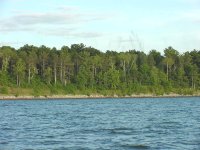 A warming trend and calmer seas are heading our way. This will fuel the "fish fly" hatches that are already underway in the area. With clouds of these insects hatching on the mid-depth flats, Walleyes are roaming out from the shallows in search of the new feeding opportunities.
A warming trend and calmer seas are heading our way. This will fuel the "fish fly" hatches that are already underway in the area. With clouds of these insects hatching on the mid-depth flats, Walleyes are roaming out from the shallows in search of the new feeding opportunities.
On several lakes, these hatches are already intense, but are mainly limited to areas of semi deep water (12 to 18 feet) and the larger May Flies are not yet present on most of the lakes. With a warming trend, we’ll soon see clouds of the larvae out in the deeper (mud flats) water too and this will signal a major Walleye move to deeper water.
Look close over the tops of these trees and you'll see clouds of "fish flies" hovering above. Not the big Mayflies just yet, but they won't be far behind. For a closer look, click on the photo.
The Fish tend to be traveling in schools of similar sizes, so if you're fishing Winnie and want "eaters". Move out of areas where you're catching the over sized "slot fish". There are plenty of the 2001 year class to go around.
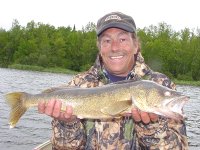 The best news about these movements is that you can fish a variety of presentations and enjoy catching some fish on most of them. During the past week bottom bouncers with spinners & crawlers have been good search baits on these large flats. In fact some of the larger fish have been caught with this method. Keep moving until you locate a school of fish with the spinners and then fine tune your presentation with jig & minnow or rigs & leeches.
The best news about these movements is that you can fish a variety of presentations and enjoy catching some fish on most of them. During the past week bottom bouncers with spinners & crawlers have been good search baits on these large flats. In fact some of the larger fish have been caught with this method. Keep moving until you locate a school of fish with the spinners and then fine tune your presentation with jig & minnow or rigs & leeches.
During the early stages of this movement, expect the locations to change on an almost daily basis and try to get in the habit of checking a variety of spots every time out. On any given day a hump or bar that was empty yesterday may be filled with fish tomorrow. The large flats with water depths of 12 to 18 feet have subtle structures like dips, gravel, rocks and inside turns that will hold fish during these transitional periods.
On windy days we fish the shallows and on calmer days we fish the deeper bars. We’re still catching plenty of fish on jig & minnow too, so if that’s your favorite, go that way and you’ll be safe for another week or maybe more.
Last week when we found a small rock pile that was holding fish, we had a great experience using slip bobbers and leeches. This is a lot of fun and works great, but you must have the fish "pinned down" in a small area where you can predict the accurate placement of your bait. Set the slip knot about 18 inches above the bottom and use a 1/16 or 1/8 oz jig head. Make sure that the leeches are swimming strongly and replace them when they start to get tired looking.
A slip bobber and leech was the clear ticket for us when we found a nice school of fish on a small rock pile.
I'm a little behind right now because of the hectic times, but I'll catch up on the rest of this report tomorrow. - Jeff Sundin 218-245-9858 or EMAIL
 Jeff Sundin Fishing Report Archive June 17, 2004 "Summer Peak? Fishing remains good to excellent in the 1000 Grand Lakes Area!"
Jeff Sundin Fishing Report Archive June 17, 2004 "Summer Peak? Fishing remains good to excellent in the 1000 Grand Lakes Area!"
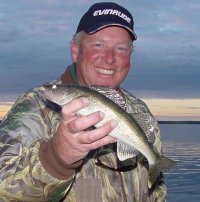 Walleye anglers are still enjoying consistent fishing. I know it sounds like a broken record, but the fish just keep biting in the shallows and jig & minnow fishing is still the best and fastest way to key in on them. The extended shallow bite this season is probably the result of water temperatures that remain in the low to mid 60-degree range coupled with the abundance of fish from the 2001-year class.
Walleye anglers are still enjoying consistent fishing. I know it sounds like a broken record, but the fish just keep biting in the shallows and jig & minnow fishing is still the best and fastest way to key in on them. The extended shallow bite this season is probably the result of water temperatures that remain in the low to mid 60-degree range coupled with the abundance of fish from the 2001-year class.
We're always showing you the big ones, but here's a look at one of the thousands of the "Class of 2001 Walleye" we've been catching. These "eaters" have put a smile on many a face this spring and early summer!
The wind has been another key to the good shallow water fishing. Because it’s been rare to get stuck with a flat calm day this season, we’ve been able to drift and jig the shallows in a number of areas. During the few calm times we’ve had, we have been able to find enough fish in the deeper water to keep us busy while we waited for the wind to pick up. The average size of the fish on the main lake bars and humps has been larger than the schools of fish in the shallows, but there are signs of increased fish movement to the deeper structures and some insect hatches are beginning to occur. Once the bug hatches get going, the deeper, softer bottom areas will gather fish quickly.
Even though we continue to catch plenty of fish with the jig & minnow, I have been fishing with live bait rigs and leech a little bit each day. At the moment, leeches are coming on strong and most days we could get plenty of fish by using leeches for everyone. I’ve gotten a few reports that spinners and/or live bait rigs with crawlers are also producing some nice catches, but we haven’t fished this way just yet.
As has been the case recently, the Walleye fishing on most of the better known Walleye lakes in 1000 Grand Lakes area are producing enough fish that you don’t have to get boxed into one lake or one style. Do your research and you’ll find at least 20 lakes with good to excellent potential and you’ll find that there is a good bite on most of these lakes right now.
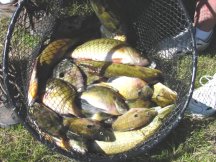 Bluegill anglers are in heaven at the moment as well. These fish have moved onto the spawning beds and are providing folks with some great action. Spawning areas are located in shallow, mixed sand, gravel and silt bottoms. The beds can be seen from some distance and it’s best to sight fish by locating the beds and cast small jigs toward them.
Bluegill anglers are in heaven at the moment as well. These fish have moved onto the spawning beds and are providing folks with some great action. Spawning areas are located in shallow, mixed sand, gravel and silt bottoms. The beds can be seen from some distance and it’s best to sight fish by locating the beds and cast small jigs toward them.
You can catch lots of the fish with a 1/32 or 1/16 ounce jig dressed with a 1-1/2 inch tube or twister tail in colors like black, brown or some of the darker greens. Be careful not to move in close enough to "spook" these fish.
Crappie fishing has been the highlight of the season for me so far. I can never remember more consistent or reliable action. Slowly but surely the spawning areas are becoming vacant and the Crappies are gathering in the deeper holes and weed beds near these spawning areas. Although we’ve still spotted some fish in bedding areas, these deeper fish are much more concentrated and have been willing biters.
My favorite approach is to locate deep pockets of "Cabbage Weeds". Crappies can be caught in and near these weeds by fishing with either a slip bobber/jig/minnow or by fishing with a jig tied direct to your line and cast toward the weeds and lift drop retrieved slowly back to the boat. In calmer water or toward evening, this casting & retrieving approach is far better than the bobbers and will get you some amazing bonus fish. Depending on the lake you can catch Walleye, Bass, Pike and Bluegills in the same areas and you can come back with the true, mixed bag.
Here's a truly mixed bag. Sunfish, Pike, Bass Crappie and Walleye. All you have to do is jig the weed line. Work slow, Use light tackle and be prepared to be amazed.
A key to this type of fishing is to let the jig drop into the weeds, so you need to use light equipment that will handle 1/16 oz or even 1/32-oz jigs. A light rod like my 7 foot G.Loomis SR842 lets me cast the light baits and I can really "feel" the structure. I can't emphasize enough the importance of using a light, sensitive rod and light line. If your equipment is too heavy, you'll have trouble casting the light baits and feeling the structure.
Cast the jig into the outer edges of these weeds and let it begin to fall, if the jig hits weeds, drop your rod tip so the line goes slack, then sharply "pop" the tip of the rod upward and most of the time the jig will be free. Let the jig fall again and continue this type retrieve until you have fished it out of the cover. If you go too heavy on the jigs, they will plow into the weeds and you will have problems getting stuck. You could become frustrated and eventually give up before you realize how great this system really works.
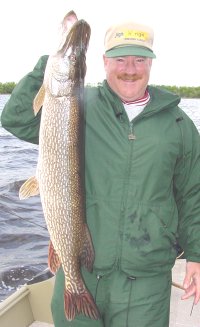 Perch action is available in a variety of covers and situations. Some fish are using the shallow gravel bars where hatching Crawfish are available. Other Perch are being found in the deeper weed patches and are frequently mixed in with the Crappie and Walleye we’ve been catching and still other schools of Perch are located on the deeper points and main lake bars. This past week, we’ve discovered that a spinner and minnow is out producing all other methods we’ve tried. The spinners can be a number two Colorado or Indiana blade on about a four-foot leader. Fish through the areas at a steady pace.
Perch action is available in a variety of covers and situations. Some fish are using the shallow gravel bars where hatching Crawfish are available. Other Perch are being found in the deeper weed patches and are frequently mixed in with the Crappie and Walleye we’ve been catching and still other schools of Perch are located on the deeper points and main lake bars. This past week, we’ve discovered that a spinner and minnow is out producing all other methods we’ve tried. The spinners can be a number two Colorado or Indiana blade on about a four-foot leader. Fish through the areas at a steady pace.
Northern Pike fishing remains consistent and with the arrival of some larger fish has become more interesting. We’re still catching tons of smaller pike on the jig & minnow combo’s, but now we are seeing some big Pike too! Casting large spoons and Spinnerbaits are producing Pike of excellent quality and in numbers good enough to make a full day out of Northern Pike fishing. The big Pike turned on this week when they moved in to the shallow areas where Walleye have been feeding. We’ve found Walleye in the stomachs of some of the Pike we’ve cleaned and I presume that there were also Walleye in the larger fish we’ve been releasing.
The big Pike location is fairly simple, stay with the first drop off from the shallow areas where Walleye, Perch or Crappie are plentiful and concentrate your efforts along the edge of this sallow drop off. Casting is my favorite, but trolling and bobbers rigged with a live sucker minnow will produce nice fish too.
In deeper main lake areas where you find schools of Walleye or Tulibees, try using a special live bait rig that you can make yourself. Tie a 2/0 hook on to a five-foot leader made of 17 to 20 pound mono line. Fish the rig with a larger (6 to 8 inch) lively minnow. Creek Chubs, Red Tails, Suckers or even large Rainbow Chubs will all work. This rig is fished in the same manner that you’d fish a live bait rig for Walleye. In fact, you’ll catch some nice Walleye fishing this method as well.
Bass fishing has escaped my attention so far this season, but the reports are good. I will try to focus on some of the key Bass information for next week’s report. - ![]() - Jeff Sundin 218-245-9858 or EMAIL
- Jeff Sundin 218-245-9858 or EMAIL
 Jeff Sundin Fishing Report Archive June 12, 2004 "Big Fish Season Is Upon Us"
Jeff Sundin Fishing Report Archive June 12, 2004 "Big Fish Season Is Upon Us"
 Walleye action continues to be good in the 1000 Grand Lakes Area and anglers continue to enjoy the benefits of the record breaking 2001year class of 13 to 14 inch fish. But now there’s a new twist. Larger fish have fully recovered from this year’s spawning runs and are feeding actively.
Walleye action continues to be good in the 1000 Grand Lakes Area and anglers continue to enjoy the benefits of the record breaking 2001year class of 13 to 14 inch fish. But now there’s a new twist. Larger fish have fully recovered from this year’s spawning runs and are feeding actively.
At times they’ll be mixed in with the large groups of smaller males that still frequent the shallows, but to key in on some great catch and release sport fishing, head for the main lake bars in deeper water. You won’t find as many fish out there just yet, but the larger fish are finding their way to these structures. This is a sign that the summer peak draws near and soon the action will be centered on many of the bars, humps and deep-water points.
Jig and minnow fishing is still reliable. We’ve been able to get good catches this past week with my favorite "Bug Eyed Shorty" tipped with either shiners or rainbows. Live bait rigs with Leeches are also producing right now and on calmer days, I’d recommend rigging part of your crew with rigs/leeches and part with jig & minnow. As one method emerges as the preference for that day, switch everyone over to the preferred bait. On windy days when the boat is moving faster, it’s likely that the jigging will work best and on calmer days, rigging leeches is an advantage.
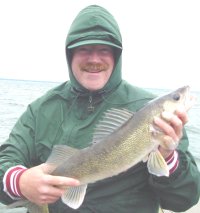 This is a great time to experiment because virtually all of the area’s better Walleye lakes are producing some nice fish. Most anglers who do their homework will be rewarded with good catches. Here’s a tip on trying new lakes; Avoid trying new water on "tough fishing days". After a cold front or on calm sunny days, use your old reliable locations. During stable weather and when conditions are favorable to you, try the new areas. You’ll learn more and learn it faster when the fish are cooperating.
This is a great time to experiment because virtually all of the area’s better Walleye lakes are producing some nice fish. Most anglers who do their homework will be rewarded with good catches. Here’s a tip on trying new lakes; Avoid trying new water on "tough fishing days". After a cold front or on calm sunny days, use your old reliable locations. During stable weather and when conditions are favorable to you, try the new areas. You’ll learn more and learn it faster when the fish are cooperating.
"Okay so it's been a little bit cold & windy lately. That hasn't slowed the fish down a bit. Walleye like this 24 inch fish released by Larry Lashley are common right now" These nicer fish are making their move toward main lake"
Crappie fishing continues to be strong!
This is one of the best early season Crappie bites that I can remember. Most anglers are doing very well, and for the most part the Crappie report is the same as last week. Crappies can be found in 3 to 8 feet of water in areas that contain gravel and light rock. These spawning stretches should be located near heavier cover like cabbage weed, bulrush or even coon tail patches. Slip bobber/jig & minnow combinations are one good choice, but we have also had great success by using a 1/16-ounce Jig tipped with a small size fathead minnow. Another nice approach is to use a 1/8-oz Beetle Spin with a twister tail. Cast the jig and fish it back toward the boat using a slow, vertical pumping motion.
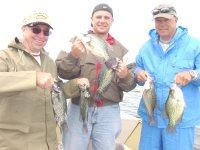 Here’s a conservation tip for spring Crappie fishing; if you want to minimize your impact on your favorite Crappie lake, select the Crappies that have turned really dark black for harvesting and release the ones that look more "normal" or appear to be full of spawn. During the spawning period it is the male Crappie that takes on this distinctive dark black color and you can catch plenty of these aggressive males to feed the family, leaving behind the females to spawn again. This will help maintain a balance in the population and give you better fishing in the future. Really!
Here’s a conservation tip for spring Crappie fishing; if you want to minimize your impact on your favorite Crappie lake, select the Crappies that have turned really dark black for harvesting and release the ones that look more "normal" or appear to be full of spawn. During the spawning period it is the male Crappie that takes on this distinctive dark black color and you can catch plenty of these aggressive males to feed the family, leaving behind the females to spawn again. This will help maintain a balance in the population and give you better fishing in the future. Really!
Bluegills and Bass are still in the early stages of the spawning run to shallow water. With some fish fanning beds in one to 3 feet of water. Bluegills are still spooky and you’ll need to go into these shallow areas in stealth mode, but some of the fish can be caught on light jigs. I like to use a feather jig like a flu-flu in 1/32 oz or 1/165 oz sizes. It shouldn’t be necessary to tip these with live bait unless the fish are extremely spooky and your attempt to catch them on the plain jig is frustrated.
Northern Pike fishing has been the highlight of the week for me as the arrival of some larger fish has caught our attention. We’re still catching tons of smaller pike on the jig & minnow combo’s, but now we are seeing some big Pike too! Casting large spoons and Spinnerbaits are producing Pike of excellent quality and in numbers good enough to make a full day out of Northern Pike fishing. The big Pike turned on this week when they moved in to the shallow areas where Walleye have been feeding.
 Big Northern Pike are starting to Roam the shallows. Casting spoons is all Jerry Volkert needed to capture and release this great Pike!
Big Northern Pike are starting to Roam the shallows. Casting spoons is all Jerry Volkert needed to capture and release this great Pike!
We’ve found Walleye in the stomachs of some of the Pike we’ve cleaned and I presume that there were also Walleye in the larger fish we’ve been releasing. The big Pike location is fairly simple, stay with the first drop off from the shallow areas where Walleye, Perch or Crappie are plentiful and concentrate your efforts along the edge of this sallow drop off.
Casting is my favorite, but trolling and bobbers rigged with a live sucker minnow will produce nice fish too.
Perch action has really started picking up. We found some small Crawfish in the stomachs of a recent catch of nice Perch and with the arrival of Crawfish hatches, come the schools of Perch to the gravel and rock bars in shallow water. Jig and minnow or live bait rig with a minnow is the preferred choice for catching these fish and one you locate a good stretch, the fish will be more than cooperative.
Perch like a vertical presentation best, but I will often cast out away from the boat and retrieve the jig to drag schools of Perch closer. Once the fish have moved in, switch back to vertical jigging until the action slows down. Repeat the process as needed. ![]() - Jeff Sundin 218-245-9858 or EMAIL
- Jeff Sundin 218-245-9858 or EMAIL
 Jeff Sundin Fishing Report Archive June 3, 2004 "Fishing Action Takes A Turn for the Better!"
Jeff Sundin Fishing Report Archive June 3, 2004 "Fishing Action Takes A Turn for the Better!"
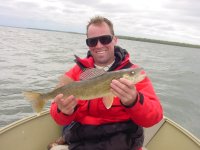 Walleye fishing has been steadily improving this week for folks that are searching for "Ol’ Marble Eyes". Water temperatures are slowly (but steadily) rising and we’ve actually broken the 60-degree barrier on a few of the darker water lakes in the area. Although, most lakes are still showing surface temps in the middle to high 50’s, with about 57 now being the average.
Walleye fishing has been steadily improving this week for folks that are searching for "Ol’ Marble Eyes". Water temperatures are slowly (but steadily) rising and we’ve actually broken the 60-degree barrier on a few of the darker water lakes in the area. Although, most lakes are still showing surface temps in the middle to high 50’s, with about 57 now being the average.
I am still asking my customers to fish jig & minnow for Walleyes, but I’ve seen some folks that are already catching Walleyes with live bait rigs using lively minnows as bait. An excellent minnow for the "rigging approach" is a 4 to 5 inch rainbow chub, hooked lightly in the lips. The swimming action helps attract fish and really keeps their attention and convinces them to bite. We observed another group of anglers this week that were using slip bobbers rigged with Leeches and fishing from an anchor position on the point or "tip" of a main lake bar. This family had 8 nice Walleyes the day we talked to them and thanks to the slip bobber approach, the kids were doing most of the catching!
We’ve all been talking about the colder water temps this spring and even though they are still below normal, the calendar is at work too. With some minor insect hatches going on, there are signs of the fish beginning to move toward deeper structures. They are also starting to be more concentrated on rock/gravel structures during windy periods especially. Main lake bars that connect to shoreline structure are also hosting some small, but active groups of fish. These are locations that will become the predominate fishing areas in the next week to ten days.
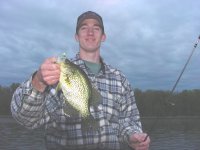 Crappie Fishing has turned on in many of the area lakes and Crappies can be found in 3 to 8 feet of water in areas that contain gravel and light rock. These spawning stretches should be located near heavier cover like cabbage weed, bullrush or even some coon tail patches. Slip bobber/jig & minnow combinations are one good choice, but we have also had great success by using a 1/16 ounce Jig tipped with a small size fathead minnow. Cast the jig and fish it back toward the boat using a slow, vertical pumping motion.
Crappie Fishing has turned on in many of the area lakes and Crappies can be found in 3 to 8 feet of water in areas that contain gravel and light rock. These spawning stretches should be located near heavier cover like cabbage weed, bullrush or even some coon tail patches. Slip bobber/jig & minnow combinations are one good choice, but we have also had great success by using a 1/16 ounce Jig tipped with a small size fathead minnow. Cast the jig and fish it back toward the boat using a slow, vertical pumping motion.
Here’s a conservation tip for spring Crappie fishing; if you want to minimize your impact on your favorite Crappie lake, select the Crappies that have turned really dark black for harvesting and release the ones that look more "normal" or appear to be full of spawn. During the spawning period it is the male Crappie that takes on this distinctive dark black color and you can catch plenty of these aggressive males to feed the family, leaving behind the females to spawn again. This will help maintain a balance in the population and give you better fishing in the future. Really!
Northern Pike action is great, but the average size fish is running a bit on the small side. In fact, some of us are trying to keep as many of these small Pike as possible to use for pickling, smoking and canning. The fish are delicious to eat and according to our DNR Regional Fisheries folks, we probably can’t even put a dent in Pike populations by harvesting these smaller fish.
The cold water of early spring/summer is perfect for these fish and they will continue to bite until the baitfish move out of the shallows.
If you have youngsters who like fast action, rig them up with a 1/8-oz jig head using a 12 inch leader you make yourself by using a swivel and 17 pound test monofilament line. This leader stays flexible, but really reduces bite-offs.
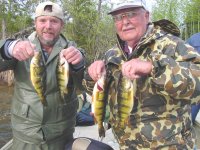 I have posted several recipes on my web site. These are great ways to utilize these fish, so your family will love going out to catch them.
I have posted several recipes on my web site. These are great ways to utilize these fish, so your family will love going out to catch them.
Perch action has really started picking up. We found some small Crawfish in the stomachs of a recent catch of nice Perch and with the arrival of Crawfish hatches, come the schools of Perch to the gravel and rock bars in shallow water. Jig and minnow or live bait rig with a minnow is the preferred choice for catching these fish and one you locate a good stretch, the fish will be more than cooperative.
Perch like a vertical presentation best, but I will often cast out away from the boat and retrieve the jig to drag schools of Perch closer. Once the fish have moved in, switch back to vertical jigging until the action slows down. Repeat the process as needed. ![]() - Jeff Sundin 218-245-9858 or EMAIL
- Jeff Sundin 218-245-9858 or EMAIL
Home | Current Fishing Report | Saved Fishing Reports | Favorite Lakes | Fishing Articles Section | Recipes | Rates Services | Gift Certificates | Contact | For Sale | Links | Sitemap |
"The Early Bird Fishing Guide" Jeff Sundin - Fishing Blue Books, LLC 715 Byington Ave, LaPrairie, MN 55744 218-245-9858
Email copyright©2018 Fishing Blue Books, LLC All Rights Reserved - last revised 2-13-18